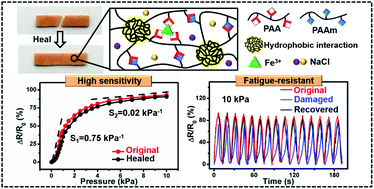Polyelectrolyte complex-based self-healing, fatigue-resistant and anti-freezing hydrogels as highly sensitive ionic skins†
Abstract
Self-healing polymeric hydrogels with high mechanical strength, excellent resilience and anti-freezing properties are fabricated for application as ionic skins with excellent and reliable sensing performances. The hydrogels are prepared by complexing polyacrylamide (PAAm) with polyacrylic acid (PAA) chelated with Fe3+ ions followed by shape processing and loading of NaCl salts. The loading of NaCl within the hydrogels can generate hydrophobic domains to enhance their mechanical strength and resilience and endow the hydrogels with ionic conductivity as high as ∼0.72 S m−1. Because of the synergy of hydrogen-bonding and coordination interactions as well as the hydrophobic domains, the resultant PAAm/PAA–Fe3+/NaCl hydrogels exhibit a high tensile strength of ∼1.18 MPa and excellent fatigue resistance. The PAAm/PAA–Fe3+/NaCl hydrogel-based ionic skins display quick, reversible and reliable resistance changes with a wide spectrum of strain (0.2–500%) and pressure (0.1–10 kPa) sensing capability. The sensing performance of the physically damaged and fatigued ionic skins can be conveniently restored by healing of the PAAm/PAA–Fe3+/NaCl hydrogels under mild conditions. Moreover, the loaded NaCl greatly decreases the freezing point of water entrapped within the PAAm/PAA–Fe3+/NaCl hydrogels to −24.7 °C, which allows the application of the ionic skins at subzero temperatures.

- This article is part of the themed collection: Journal of Materials Chemistry A Lunar New Year collection 2021


 Please wait while we load your content...
Please wait while we load your content...